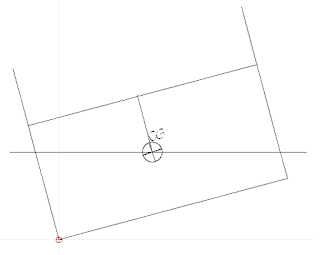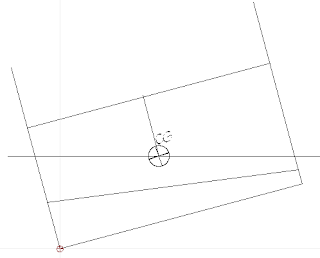Next
to last kick at the stability cat
Well
it turns out that it does work for small round bottom boats and boats
without two parallel sides. I wouldn't say that it is one hundred per
cent accurate but for the boats we're dealing with it's close enough.
Here's how we go about it .
This
is the hull we dealt with last time,
So
I took that hull shape and rounded off the corners, gives a sort of
canoe shape,
We'll
keep the centre of gravity the same but the waterline needs adjusting
to account for the change in underwater shape. Once that is done then
we're going to create a trapezoid, first by cutting off the round
parts, those volumes are so small, and equal in area, 50 sq inches,
that it makes little difference to the calculation at this juncture.
Now
we're going to join the upper ends of those lines that cut off the
round part to make a trapezoid and a triangle and then find the
centre of those bodies as we did previously.
Once
we have both centres then we need to do some calculation, first we'll
join both centres with a line. Our centre of buoyancy is somewhere on
that line. But where.
In
my last post I sent you to Jim Michalak's page here,
http://www.jimsboats.com/1dec15.htm
where he sets out how to calculate the center of effort of sails. We
can do the same thing here. So lets name the triangle area small or
AS and the trapezoid AL. We'll call the line joining the two centres
LS-LL. Now we measure the area of AS and AL and the length of LS-LL
AS
is 131.45 sqin and AL is 270.75 sqin, LS-LL is 12”. Divide AS into
AL and add 1, that come out to 3.06. Divide LS-LL by 3.06, which is
3.9. The center of buoyancy is 3.9 inches from LL.
I
can hear the mathematicians out there saying that's not right! But
here's an example using a lever and fulcrum.
How
much weight do we have to hang off the end of the nine foot arm to
balance the lever assuming the lever weighs nothing? (which is what
we're actually doing when we calculate the relative distance of the
centres of our areas)
10x3/9
= 3.33 lbs
So
now lets turn that around and say where do we put the fulcrum to
balance a 10 lb weight and a 3.33 lb weight on a 12 foot lever?
((10/3.33)+1)
divided into 12' = 3' from the heavy end.
Getting
back to our vessel, at 5 degrees of heel the righting arm is 2.5”
and GM is 2' 4.8”
How
does that compare with our square bottom vessel? At the same degree
of heel the square boat had a righting arm of 1” and a GM of a foot
however if you overlay the two at the waterline,the centres of
buoyancy are almost identical.
Next
time a quick look at a greater degree of heel and a rounder bottom vessel and one without parallel sides.


















